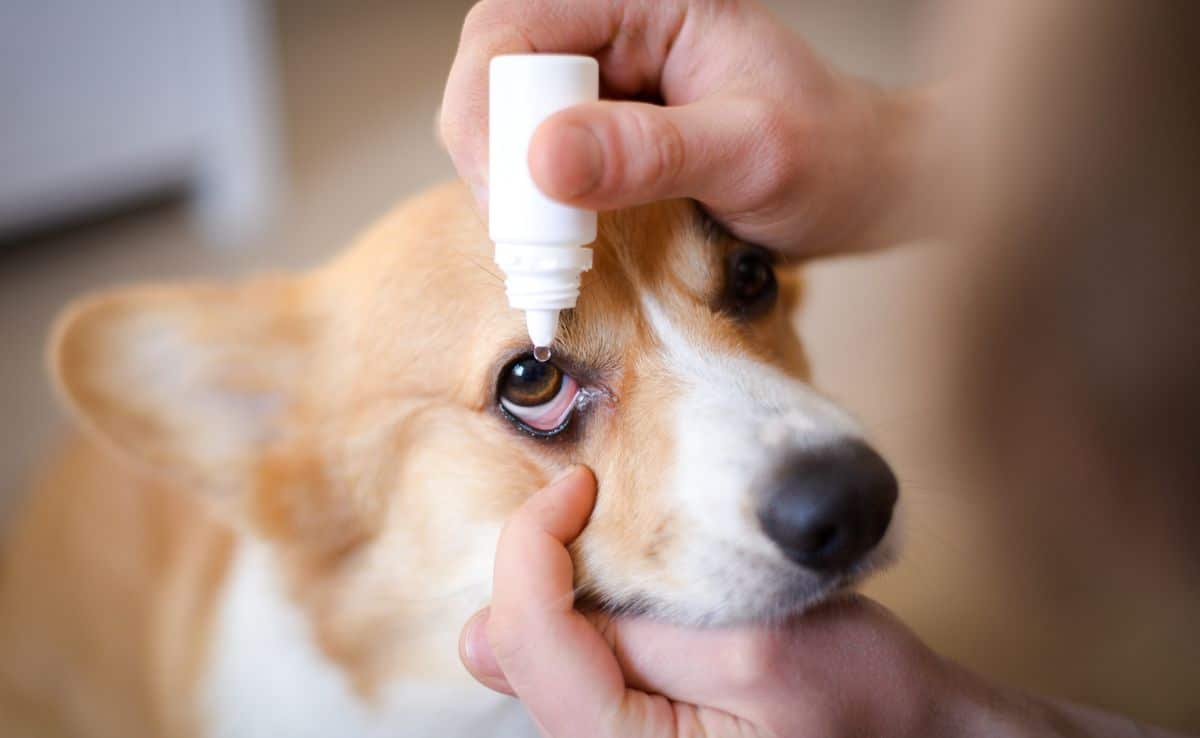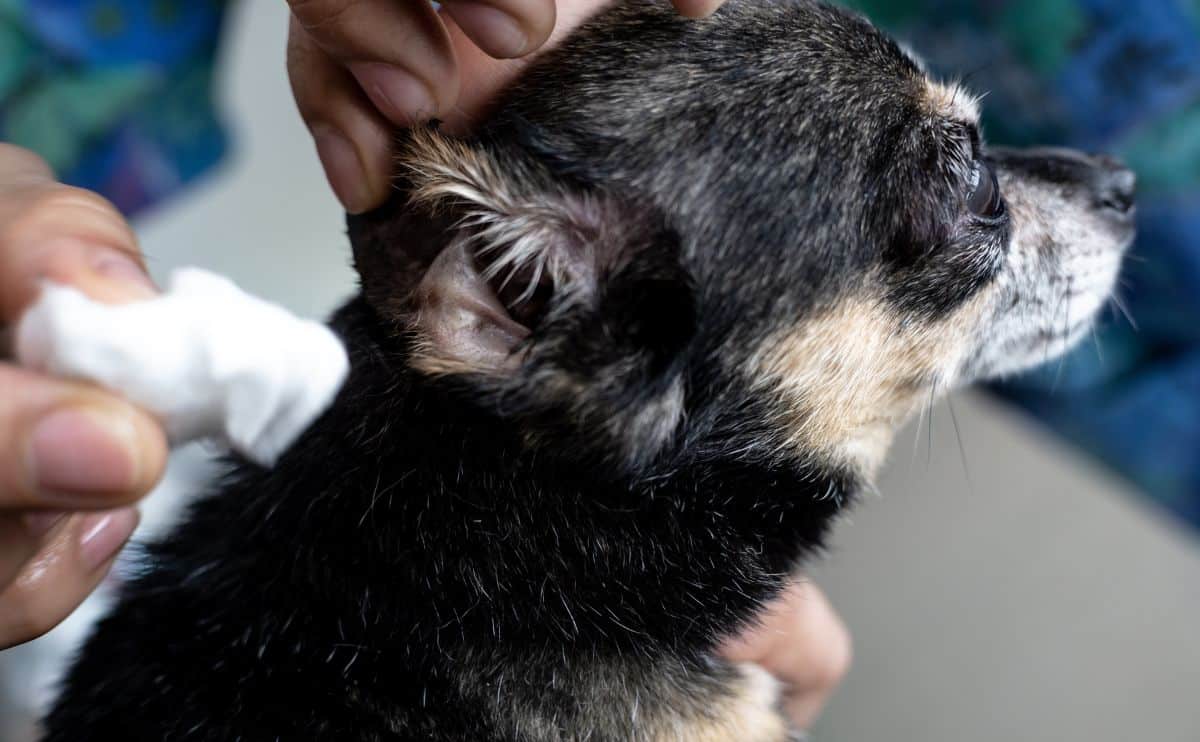59% of Dogs Struggle with This—Does Yours?
When you purchase through links on our site, we may earn a commission. Here’s how it works.
Obesity in dogs is more than just a cosmetic issue—it’s a serious health concern that can shorten your pet’s lifespan and lead to severe medical conditions. Even a few extra pounds can put unnecessary strain on their body, affecting mobility, heart health, and even their risk for diseases like diabetes.
Table of Contents

The good news? You can help your dog shed those extra pounds and regain energy with the right approach. This guide will walk you through the risks of obesity, how to determine if your dog is overweight, and a step-by-step weight loss plan template to get them back to a healthy weight.
Why Canine Obesity Is A Problem
Excess weight in dogs isn’t just about appearance; it can seriously affect their overall well-being. Studies show that obese dogs are more likely to suffer from chronic illnesses, mobility issues, and even reduced lifespan. Before determining if your dog is overweight, let’s examine why keeping your pup at a healthy weight is so important.
According to a 2022 Veterinary Clinic Prevalence Survey from the Association for Pet Obesity Prevention (APOP), 59% of canines in the U.S. are overweight or obese. This marks an increase from APOP’s last survey in 2018, which found that 55.8% of dogs evaluated in veterinary clinics were classified as clinically overweight or obese.
Banfield Pet Hospital’s 2020 VET Report also highlighted the prevalence of obesity in dogs. The report revealed that 51% of the 1.9 million adult dogs seen at Banfield clinics nationwide in 2018 were overweight. Additionally, June 2021 data from Banfield Pet Hospital showed a 108% increase in dogs diagnosed as overweight or obese over the past ten years, emphasizing the rapid rise of obesity-related health issues in pets.
Both overweight and obese conditions continued to increase in 2021 and 2022 before showing a slight decline in 2023. However, obesity-related health complications, particularly osteoarthritis (OA), remain a significant concern.
OA can significantly impact a pet’s quality of life, and research suggests that it plays a role in owner decisions regarding euthanasia. Data indicates that within 12 months of an OA diagnosis, 16.5% of dogs are euthanized for OA-related reasons, highlighting the devastating impact of obesity-related joint diseases.
Despite these alarming numbers, many pet owners may not recognize their dog’s weight issues. A Winter 2023 survey by APOP—appearing in the same report that found 59% of canines in the U.S. are overweight or obese—revealed a concerning lack of awareness. Only 17% of dog owners acknowledged that their pets were overweight, while a staggering 84% believed their dog’s body condition was healthy. This disconnect suggests that many cases of obesity go unnoticed, delaying necessary interventions.
How To Tell If Your Dog Is Overweight (With A Simple Test!)
Maintaining a healthy weight is crucial for your dog’s overall well-being, as obesity can lead to serious health issues such as joint problems, diabetes, heart disease, and more. Not sure if your furry friend is carrying a little extra baggage? By assessing your dog’s body condition, you can take proactive steps to prevent health complications and ensure they live a long, healthy life.
Understanding Dog Body Condition Scoring
Veterinarians use the Body Condition Score (BCS) system to assess a dog’s weight. Based on fat distribution and body shape, this nine-point scale helps determine whether a dog is underweight, ideal, or overweight.
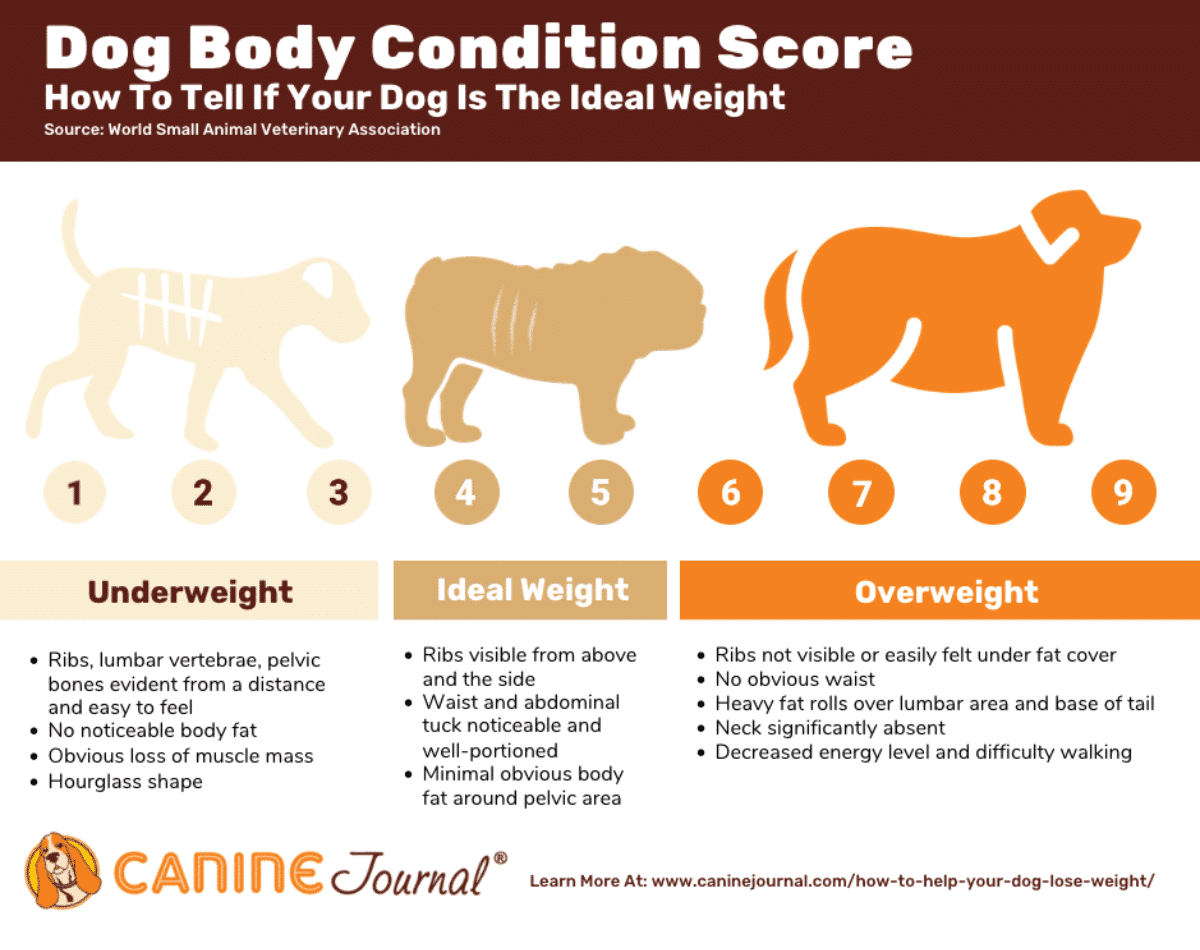
If your dog falls in the 6-9 range, it’s time to take action to help them reach a healthier weight.
Rib Check: The Hands-On Approach
The rib check is one of the simplest yet most effective ways to evaluate your dog’s weight at home. Gently place your hands on their sides and run your fingers over the rib area. Ideally, you should be able to feel each rib easily through a thin layer of fat, but they shouldn’t be overly pronounced or sticking out. If you need to press firmly to locate the ribs, your dog may be carrying excess fat.
If the ribs are difficult to detect, your pup’s caloric intake likely exceeds their energy expenditure. Adjusting their diet and incorporating more exercise can help them achieve a healthier body composition.
Waistline: The Bird’s Eye View
Stand above your dog while they are standing naturally. A fit dog should have a noticeable waist that narrows just behind the ribcage. If your pup’s body shape resembles a sausage or a barrel, with no visible tapering, it strongly indicates excess weight.
Maintaining a visible waistline is essential for mobility and comfort. Excess fat around this area can contribute to overheating, fatigue, and an overall sluggish demeanor.
Abdominal Tuck: The Side Profile Test
Take a look at your dog from the side while they are standing. A healthy dog should have a slight upward slope from the ribcage to the abdomen, often called an abdominal tuck. If your dog’s belly appears to sag or hang low with no visible tuck, it may be a sign of obesity.
An absent abdominal tuck often correlates with a higher body fat percentage, which puts pressure on the joints and organs, increasing the likelihood of health complications.
Energy Levels & Activity Tolerance
Your dog’s enthusiasm for exercise can also indicate their weight status. Overweight dogs often exhibit:
- Shortness of breath or excessive panting after minimal activity
- Fatigue or reluctance to move, preferring to lay down instead of playing
- Difficulty keeping up during walks or play sessions
If your pup seems sluggish or uninterested in activities they once enjoyed, their weight might be a contributing factor. Encouraging low-impact activities, such as swimming or short walks, can help gradually rebuild their stamina.
Other Warning Signs Of Excess Weight
Beyond physical assessments, additional signs of canine obesity include:
- Labored breathing, even at rest
- Difficulty jumping onto furniture or into the car
- Pressure sores or calluses on joints, which develop from prolonged lying due to excess weight
- Skin folds or irritation, which can lead to infections in overweight dogs
If you’re unsure whether your dog is at a healthy weight, schedule a vet check-up to get a professional evaluation. Your veterinarian can help determine your dog’s ideal weight range based on their breed, age, and body composition.
Pro Tip: Compare your dog’s weight with our Overweight Dog Chart below!
The Overweight Dog Chart: What’s Normal & What’s Not
Understanding the healthy weight range for your dog’s breed is essential in maintaining their overall health. Below is a chart showcasing some of the most popular dog breeds in the United States and their respective healthy weight ranges.
| Dog Breed | Healthy Weight Range |
|---|---|
| Beagle | 20-30 lbs |
| Bulldog | 40-50 lbs |
| Dachshund | 16-32 lbs |
| French Bulldog | 16-28 lbs |
| German Shepherd | 50-90 lbs |
| German Shorthaired Pointer | 45-70 lbs |
| Golden Retriever | 55-75 lbs |
| Labrador Retriever | 55-80 lbs |
| Poodle | 40-70 lbs |
| Rottweiler | 80-135 lbs |
For a more detailed breakdown of your dog’s ideal weight, refer to this guide on healthy dog weights. Always consult your veterinarian for breed-specific recommendations, as individual dog’s needs may vary.
The Surprising Reasons Dogs Get Fat
Many pet owners assume that diet is the only factor in canine weight gain, but the reality is far more complex. Several underlying causes contribute to excess weight in dogs, and understanding them can help you take proactive steps to manage your pup’s health.
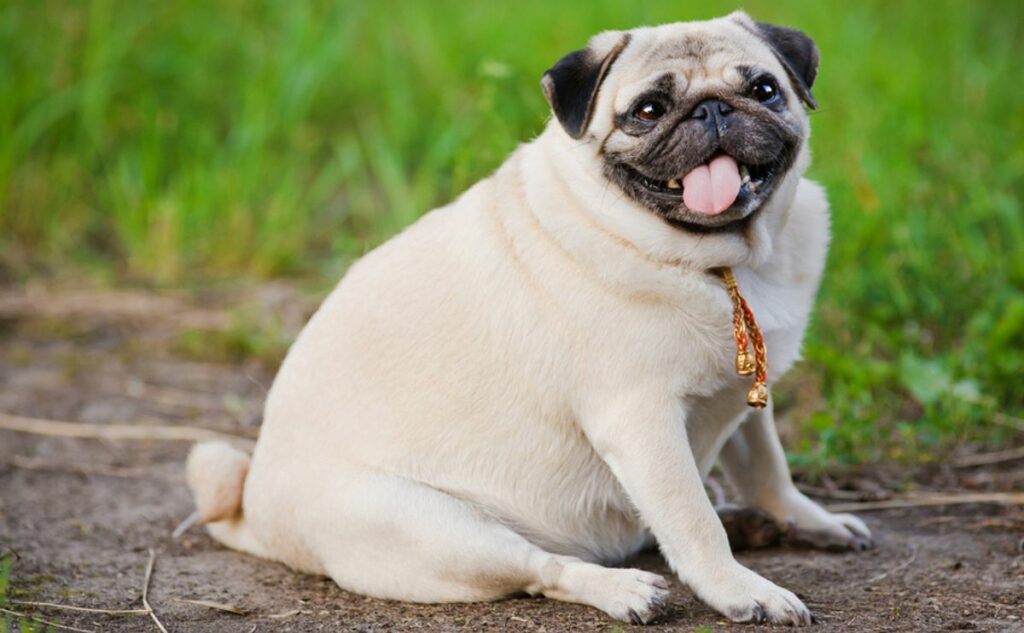
Too Many Calories, Not Enough Activity
Like humans, dogs gain weight when they consume more calories than they burn. Many pet parents overestimate their dog’s energy needs or give too many treats, leading to gradual weight gain. Some of the biggest culprits include:
- Free-feeding (leaving food out all day)
- High-calorie snacks (cheese, peanut butter, table scraps)
- Infrequent or insufficient exercise
- Seasonal weight gain due to reduced outdoor activity in winter months
Solution: Measure your dog’s food portions carefully, reduce unhealthy treats, and ensure they get at least 30-60 minutes of activity daily based on their breed and size. If cold weather limits outdoor activity, consider indoor exercise alternatives like stair climbing, interactive toys, or treadmill walking.
Medical Conditions That Cause Weight Gain
Some dogs struggle with obesity despite a healthy diet and exercise routine. Certain medical conditions can slow metabolism and lead to fat accumulation, including:
- Arthritis or pain issues: If your dog has joint pain, they may move less, contributing to weight gain.
- Hypothyroidism: A common condition where the thyroid doesn’t produce enough hormones, resulting in weight gain and sluggishness.
- Cushing’s disease: A disorder that causes excess cortisol production, leading to increased appetite and fat storage.
Solution: If you notice unexplained weight gain, consult your veterinarian for a check-up. Blood tests can diagnose underlying issues, and treatment can help regulate weight.
The Hidden Role Of Obesogens In Canine Obesity
Recent research suggests that certain environmental chemicals, known as obesogens, may contribute to obesity in humans and pets by disrupting the hormones that regulate metabolism and fat storage. When dogs are exposed to these chemicals (via dog food, plastics, pesticides, grooming products, and more), their bodies may be more prone to storing fat, even if their diet and exercise levels remain unchanged.
Solution: Reduce exposure by using stainless steel or ceramic food bowls, choosing organic pet food when possible, and avoiding plastic food storage containers. Bathing your dog regularly can also help remove environmental toxins from their fur.
How Spaying & Neutering Affect Weight Gain
Spaying and neutering can affect a dog’s metabolism, sometimes leading to weight gain if food portions and activity levels aren’t adjusted. This happens because hormonal changes after surgery can lower energy needs, meaning a dog will gain weight if fed the same amount as before the procedure.
Solution: After spaying or neutering, consider adjusting your dog’s food intake by reducing caloric content and increasing daily exercise to compensate for metabolic changes.
Genetic Predisposition: Are Some Breeds Prone To Obesity?
Certain breeds naturally have slower metabolisms or stronger appetites, making them more prone to weight gain. Some of the most commonly affected breeds include:
- Labrador Retrievers (famously food-driven)
- Beagles (high food motivation)
- Cocker Spaniels (prone to hypothyroidism)
- Dachshunds (low activity levels can lead to obesity)
- Basset Hounds (prone to gaining weight due to a slower metabolism)
Solution: If your dog’s breed is known for weight struggles, be extra mindful of portion control and engage them in daily play and walks to keep their metabolism active.
Why Older Dogs Gain Weight More Easily
As dogs grow older, their metabolism naturally slows down, making it easier for them to gain weight—even if their diet remains the same. Senior dogs also tend to be less active, leading to a gradual accumulation of fat.
Solution: Adjust your dog’s calorie intake as they age and incorporate gentle, joint-friendly exercises like swimming or short, frequent walks to maintain a healthy weight.
Stress & Emotional Eating In Dogs
Dogs can overeat due to stress or boredom. If a dog is left alone for long hours, they may turn to food for comfort. Anxiety can also lead to disrupted metabolism, affecting weight regulation.
Solution: Ensure your dog has enough mental stimulation, such as puzzle toys, interactive play, and socialization, to prevent overeating caused by boredom or stress.
Best Dog Food for Weight Loss: What Vets Recommend
When choosing a weight-loss food for your dog, it’s important to look for high-protein, fiber-rich, and low-calorie formulas that help maintain lean muscle while promoting fat loss. Many commercial weight-loss foods contain added fiber to help dogs feel fuller for longer, reducing overeating and begging behaviors.
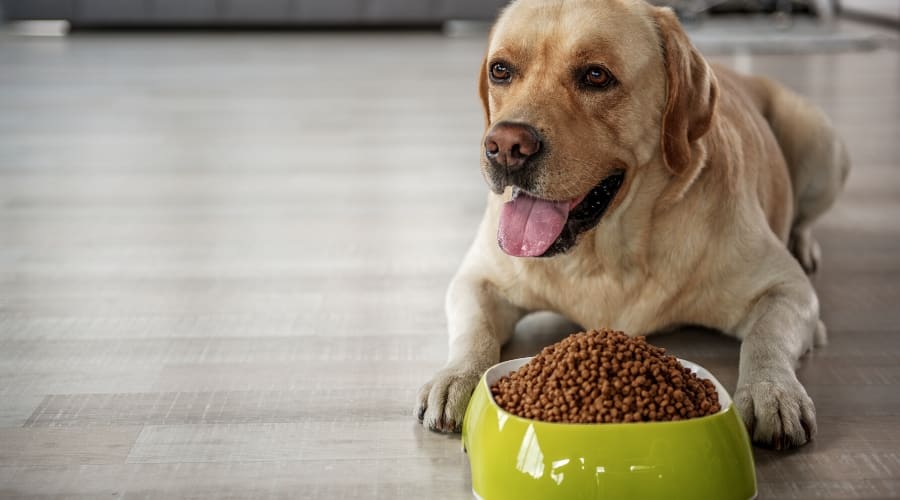
What to Look for in Weight-Loss Dog Food
- High protein content: Helps maintain muscle mass while shedding fat
- Increased fiber: Promotes satiety and reduces unnecessary snacking
- Low fat/caloric density: Helps reduce overall calorie intake
- L-carnitine: Aids fat metabolism and weight management
Here’s a quick comparison of top-rated weight-loss dog foods recommended by vets:
| Brand | Calories Per Cup | Key Benefits |
|---|---|---|
| Hill’s Science Diet Adult Perfect Weight | 299 kcal | Formulated for weight loss and maintenance, supports lean muscle |
| Blue Buffalo Life Protection Formula Healthy Weight | 322 kcal | No artificial flavors or preservatives, contains prebiotic fiber |
| Royal Canin Medium Weight Care | 230 kcal | Formulated for weight management, high fiber |
(Always transition dog food gradually to avoid digestive issues.)
How Much To Feed Overweight Dogs
One rule of thumb is to reduce your dog’s daily caloric intake by one-third, but this can be over-generalized for many dogs. We recommend consulting with your veterinarian, who can calculate your pup’s daily caloric needs to lose weight safely.
Every dog is different, and vets consider many factors, including breed, ideal weight, size, activity level, how much weight they need to lose, etc. Also, if you have an overweight puppy or senior dog, their caloric needs will differ from adult dogs.
The Hidden Health Risks Of Dog Obesity
Excess weight in dogs is more than just an aesthetic issue—it significantly increases the risk of severe health conditions, reduces life expectancy, and impacts a dog’s overall quality of life. Studies have shown that obese dogs live up to 2.5 years shorter than dogs at a healthy weight. Below are some of the most common and dangerous health risks associated with canine obesity.
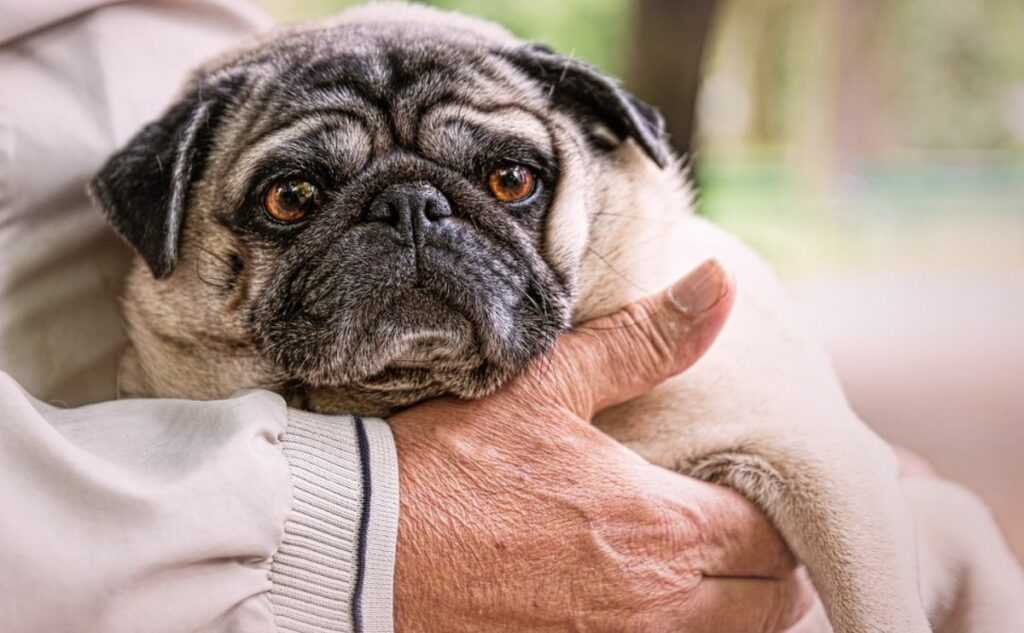
Metabolic, Kidney & Organ-Related Risks
- Diabetes: Overweight dogs are more likely to develop insulin resistance, increasing the risk of diabetes.
- Kidney disease: Excess weight can strain kidney function, increasing the risk of chronic kidney disease.
- Liver disease: Obesity can contribute to fatty liver disease, a dangerous liver condition.
- Increased risk of cancer: Studies suggest that overweight dogs have a higher likelihood of developing certain cancers.
Cardiovascular & Respiratory Risks
- Heart disease & high blood pressure: Excess fat raises the risk of cardiovascular problems, just like in humans.
- Respiratory issues: Overweight dogs may struggle with breathing difficulties, especially in brachycephalic breeds (e.g., Bulldogs, Pugs).
Mobility & Energy Concerns
- Joint & mobility issues: Extra weight puts pressure on the joints, leading to arthritis and difficulty moving.
- Reduced stamina & heat intolerance: Carrying extra weight can make dogs tire quickly and struggle in warm temperatures.
- Digestive issues & bloating: Excess fat can increase the risk of gastric torsion and other digestive problems.
Keeping your dog at a healthy weight can extend their lifespan, improve their quality of life, and prevent these serious health conditions. If your dog is overweight, it’s time to take action now.
Success Stories: How Real Dogs Shed The Pounds
These inspiring transformation stories come from Canine Journal team members, showcasing real-life weight-loss journeys that prove any dog can achieve a healthier lifestyle with the right approach.
Seeing real-life transformations can be incredibly motivating for dog owners trying to help their pets lose weight. Here are two inspiring success stories of overweight dogs who achieved healthier lifestyles through proper diet and exercise.

Rio The Golden Retriever: From Heavy To Healthy
- Starting Weight: 133 lbs
- Final Weight: 103 lbs (and counting…)
- Timeframe: 5 months
Approach: Rio’s owner, Tara, implemented a structured weight-loss plan that included calorie restriction and multiple daily walks—plus additional play and running sessions. She also tracked Rio’s activity using the Petcube activity tracker and added a daily probiotic supplement to his regimen to support his gut health. Thanks to this routine, Rio has already lost 30 pounds and continues to work toward his ideal weight.
Lexie The Cavalier King Charles Spaniel: Thriving On Fresh Food
Approach: Lexie’s transformation began when her owner, Sadie, switched her to The Farmer’s Dog, a premium fresh food diet. Since making the change, Lexie has been eating enthusiastically and has experienced more consistent digestion. She’s lost excess weight and now maintains a healthy physique. Plus, her coat is now noticeably shinier and healthier.
Your Action Plan: Helping Your Dog Lose The Weight For Good
Helping your dog achieve a healthy weight doesn’t have to be overwhelming. By following a structured plan that includes diet, exercise, and monitoring, you can set your pup up for long-term success.

Ready to make a change? Follow this 3-step weight loss plan:
Step 1: Determine Your Dog’s Ideal Weight
Start by assessing your dog’s current weight using a Body Condition Score (BCS) or comparing it to breed standards. Consult with your veterinarian to set a realistic target weight and a timeline for healthy weight loss (typically 1-2% of body weight per week).
Step 2: Adjust Diet & Portion Control
- Calculate daily calorie needs: Use your vet’s recommendation or an online dog calorie calculator.
- Choose a high-protein, fiber-rich weight-loss food to help maintain muscle mass while promoting fat loss.
- Eliminate table scraps & limit treats to no more than 10% of daily calories.
- Meal timing matters: Split meals into two to three smaller portions to regulate digestion and prevent overeating.
Step 3: Implement A Structured Exercise Plan
- Daily walks: Aim for 30-60 minutes of walking daily, split into multiple sessions.
- Low-impact activities: Swimming or controlled leash walks for overweight or senior dogs.
- Engaging playtime: Fetch, tug-of-war, or interactive toys to encourage movement.
- Track progress: Use activity monitors (like FitBark or Tractive) to ensure consistency.
Check out this list of 20 fat-burning exercises for you and your dog!
Sample Daily Plan for Weight Loss
| Time | Activity |
|---|---|
| 7:00 AM | 20-minute morning walk |
| 8:00 AM | Breakfast (measured portion) |
| 12:00 PM | Interactive play or training session |
| 3:00 PM | 15-minute midday walk |
| 6:00 PM | Dinner (measured portion) |
| 7:30 PM | Light evening walk or playtime |
Stay Consistent & Monitor Progress
Weigh your dog every 2-4 weeks to track progress and adjust the plan as needed. Small, gradual improvements will lead to long-term success!
Take action today! Start your dog’s weight-loss journey and celebrate their progress along the way. Let us know how your pup is doing in the comments below!
Additional Weight Loss Solutions For Dogs
If diet and exercise alone aren’t yielding the desired results, additional strategies can help support your dog’s weight-loss journey.

Alternative Diet Strategies
For those not wanting to take the prescription dog food route, follow these guidelines for a weight-busting dog food.
- High-protein, high-fiber diets: Look for weight-loss foods rich in protein and fiber to keep your dog full and maintain muscle mass.
- Fat can be your dog’s friend: Healthy fats like omega-3s and medium-chain triglycerides (MCTs) can actually aid weight loss by promoting satiety, reducing inflammation, and supporting metabolism.
- Avoid antibiotics & hormones in meat: Choose organic or antibiotic-free meats, as additives in commercial meats have been linked to weight gain.
- No artificial fillers: Avoids unnecessary carbs that can contribute to weight gain.
- Try fresh dog food: Some owners have had success switching from kibble to fresh, human-grade meals like The Farmer’s Dog, which can improve digestion and metabolism.
Supplements For Weight Management
While supplements alone won’t lead to weight loss, they can support metabolism, joint health, and digestion:
- Omega-3 fatty acids: Found in fish oil, they promote fullness and reduce inflammation.
- Probiotics: Support gut health, which plays a role in digestion and metabolism.
- L-Carnitine: Helps burn fat and supports energy levels.
- Calcarea carbonica: A homeopathic remedy that may aid in weight control for dogs with hormonal imbalances.
Prescription Weight-Loss Medications
For severely obese dogs, veterinarians may prescribe Slentrol (dirlotapide), an FDA-approved medication for canine obesity.
- How it works: Reduces appetite and fat absorption.
- Veterinary supervision required: Regular checkups are needed to adjust dosages.
- Possible side effects: Some dogs may experience vomiting, diarrhea, or changes in appetite.
Ozempic For Dogs: What You Need To Know
Recently, there has been growing interest in the use of Ozempic (semaglutide) and other GLP-1 receptor agonists for weight loss in dogs. While Ozempic is FDA-approved for humans with type 2 diabetes, its potential role in canine weight management is still being explored.
For a deeper dive into this topic, check out our full article: Ozempic for Dogs: Is It Safe for Weight Loss?
Frequently Asked Questions
Here are some of the most common questions about dog and pet obesity. Don’t see yours? Ask us in the comments!
How Much Weight Should My Dog Lose Per Week?
A safe weight-loss goal is 1-2% of their total body weight per week. Rapid weight loss can be harmful, so gradual progress is ideal.
What Is The Best Exercise For An Overweight Dog?
Low-impact activities like short walks, swimming, and interactive play are great for overweight dogs. Avoid excessive running or jumping, as excess weight can put stress on their joints.
Should I Be Concerned If My Dog Is Always Hungry On A Diet?
It’s normal for dogs to adjust to smaller portions. Try feeding high-fiber foods, using puzzle feeders, and dividing meals into smaller portions throughout the day to help them feel fuller longer.
What If My Dog Is Overweight But Doesn’t Eat Much?
If you’re sure your dog isn’t sneaking food from other pet bowls and getting enough exercise, there could be an underlying health problem. For example, Cushing’s disease or hypothyroidism could be causing your dog to be overweight despite not eating much. So, it’s essential to take your dog to the vet to get tested for any possible diseases.
Can Older Dogs Lose Weight?
Yes, but their metabolism is slower, so weight loss may take longer. Senior dogs benefit from low-impact exercise and a controlled-calorie diet to help shed excess weight safely.
Is A Raw Diet Good For Weight Loss In Dogs?
While some owners report success with raw diets, they can be high in fat and difficult to balance nutritionally. Consult your vet before making any major dietary changes.
What If My Dog Refuses To Exercise?
Start slow—short walks, playtime, or gentle movements can build endurance. Some overweight dogs may need vet-supervised physical therapy or hydrotherapy to get started.
How To Help Your Pup Lose Weight
Regardless of whether your dog is obese or just carrying around a couple of extra pounds, it’s time to take action to get your pup to his ideal, healthy weight. You can help your dog lose weight by putting him on a diet or getting more exercise.
Changing your dog’s daily habits will take some time, so be patient as your dog adjusts. And be sure to consult with your vet to develop the best plan for your pup’s specific weight loss needs.
Why Trust Canine Journal?
Sally has over 20 years of experience in human health sciences communications, including more than 10 years as an expert on pet health conditions and treatment. She’s part of a team of dedicated canine professionals and long-time dog owners at Canine Journal. We test and research the best pet products, not only for our own pups but for all of our readers.
